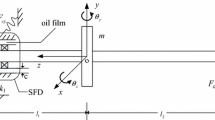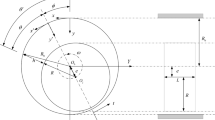Abstract
A high-speed rotating rotor system mounted on a moving vehicle is inevitably subjected to parametric excitations and exciting forces induced by base motions. Dynamic characteristics of a rotor-bearing system supported by squeeze-film damper with retainer spring subjected to unbalance and support motions are investigated. Using Lagrange’s principle, equations of motion for rotor system relative to a moving support are derived. Under base excitations, steady-state and transient responses are analyzed by frequency–amplitude curve, waveform, orbit, frequency spectrum, and Poincaré map. Changing with rotating speed or base harmonic frequency, journal motions are analyzed by bifurcation diagram. The results indicate that under base axial rotation, increasing base angular velocity, first two critical speeds decrease but resonant amplitudes increase slightly. The journal whirls around the static eccentricity with noncircular orbit. Under base lateral rotation, critical speeds, and resonant amplitudes remain essentially unchanged, but orbit’s deviation is related to base angular velocity. Excited by base harmonic translation, the integral multiples of fundamental frequency \(k{\varOmega }\left( {k = 1,2} \right)\), base harmonic frequency \({\varOmega}^{z}\), and combined frequencies \(k{\varOmega } \pm j{\varOmega }^{z} { }\left( {k,j = 1,2} \right)\) are stimulated, changing the motions from periodic to quasiperiodic. Overall, it provides a flexible approach with good expandability to predict dynamic characteristics of squeeze-film damped rotor system under base motions.































Similar content being viewed by others
References
Barrett, L.E., Gunter, E.J.: Steady State and Transient Analysis of a Squeeze Film Damper Bearing for Rotor Stability. National Aeronautics and Space Administration, Washington, DC (1975)
Holmes, R., Dogan, M.: Investigation of a rotor bearing assembly incorporating a squeeze-film damper bearing. J. Mech. Eng. Sci. 24(3), 129–137 (1982). https://doi.org/10.1243/JMES_JOUR_1982_024_026_02
Holmes, R., Dogan, M.: The performance of a sealed squeeze-film bearing in a flexible support structure. Proc. Inst. Mech. Eng. Part C J. Mech. Eng. Sci. 199(1), 1–9 (1985). https://doi.org/10.1243/PIME_PROC_1985_199_084_02
Holmes, R., Sykes, J.E.H.: The vibration of an aero-engine rotor incorporating two squeeze-film dampers. Proc. Inst. Mech Eng. Part G J. Aerospace Eng. 210(7), 39–51 (1996). https://doi.org/10.1243/PIME_PROC_1996_210_343_02
Vance, J.M.: Rotordynamics of Turbomachinery. Wiley, New York (1988)
Mclean, L.J., Hahn, E.J.: Unbalance behavior of squeeze film damped multi-mass flexible rotor bearing systems. J. Lubr. Technol. 105(1), 22–28 (1983). https://doi.org/10.1115/1.3261094
Mclean, L.J., Hahn, E.J.: Stability of squeeze film damped multi-mass flexible rotor bearing systems. J. Tribol. 107(3), 402–409 (1985). https://doi.org/10.1115/1.3261094
Zhao, J.Y., Linnett, I.W., Mclean, L.J.: Stability and bifurcation of unbalanced response of a squeeze film damped flexible rotor. J. Tribol. 116(2), 361–368 (1994a). https://doi.org/10.1115/1.2927236
Zhao, J.Y., Linnett, I.W., Mclean, L.J.: Subharmonic and quasi-periodic motions of an eccentric squeeze film damper-mounted rigid rotor. J. Vib. Acoust. Trans. ASME 116(3), 357–363 (1994b). https://doi.org/10.1115/1.2930436
Bonello, P., Brennan, M.J., Holmes, R.: Non-linear modelling of rotor dynamic systems with squeeze film dampers—an efficient integrated approach. J. Sound Vib. 249(4), 743–773 (2002). https://doi.org/10.1006/jsvi.2001.3911
Bonello, P., Hai, P.M.: A receptance harmonic balance technique for the computation of the vibration of a whole aero-engine model with nonlinear bearings. J. Sound Vib. 324(1–2), 221–242 (2009). https://doi.org/10.1016/j.jsv.2009.01.039
Inayat-Hussain, J.I.: Bifurcations in the response of a flexible rotor in squeeze-film dampers with retainer springs. Chaos Solitons Fract. 39(2), 519–532 (2009). https://doi.org/10.1016/j.chaos.2007.01.086
Chu, F.L., Holmes, R.: The effect of squeeze film damper parameters on the unbalance response and stability of a flexible rotor. J. Eng. Gas Turbines Power 120(1), 140–148 (1996). https://doi.org/10.1115/1.2818065
Chu, F.L., Holmes, R.: Efficient computation on nonlinear responses of a rotating assembly incorporating the squeeze-film damper. Comput. Methods Appl. Mech. Eng. 164(3), 363–373 (1998). https://doi.org/10.1016/S0045-7825(98)00097-8
Chu, F.L., Holmes, R.: The damping capacity of the squeeze film damper in suppressing vibration of a rotating assembly. Tribol. Int. 33(2), 81–97 (2000). https://doi.org/10.1016/S0301-679X(00)00030-X
Wang, S.J., Liao, M.F., Li, W.: Vibration characteristics of squeeze film damper during maneuver flight. Int. J. Turbo Jet-Eng. 32(2), 193–197 (2015). https://doi.org/10.1515/tjj-2014-0020
Shoyama, T.: Nonlinear vibration of saturated water journal bearing and bifurcation analysis. J. Vib. Acoust. Trans. ASMEe 141(2), 021016 (2019). https://doi.org/10.1115/1.4042041
Soni, A.H., Srinivasan, V.: Seismic analysis of a gyroscopic mechanical system. J. Vib. Acoust. Stress Reliab. Design Trans. ASME 105(4), 449–455 (1983). https://doi.org/10.1115/1.3269127
Srinivasan, V., Soni, A.H.: Seismic analysis of a rotor-bearing system. Earthq. Eng. Struct. Dyn. 12(3), 287–311 (1984). https://doi.org/10.1002/eqe.4290120302
Samali, B., Kim, K.B., Yang, J.N.: Random vibration of rotating machines under earthquake excitations. J. Eng. Mech ASCE 112(6), 550–565 (1986). https://doi.org/10.1061/(asce)0733-9399(1986)112:6(550)
Kim, K.B., Yang, J.N., Lin, Y.K.: Stochastic response of flexible rotor-bearing systemto seismic excitations. Probab. Eng. Mech. 1(3), 122–130 (1986). https://doi.org/10.1016/0266-8920(86)90021-4
Suarez, L.E., Singh, M.P., Rohanimanesh, M.S.: Seismic response of rotating machines. Earthq. Eng. Struct. Dyn. 21(1), 21–36 (1992). https://doi.org/10.1002/eqe.4290210102
Lund, J.W.: Modal response of a flexible rotor in fluid-film bearings. J. Eng. Ind. Trans. ASME 96(2), 525–533 (1974). https://doi.org/10.1115/1.3438360
Koike, H., Ishihara, K.: Impact response of rotor-bearing system to an arbitrary excitation of pedestals (1st report: comparison of linear analysis with experiment). Bull. JSME 26(220), 1783–1790 (1983). https://doi.org/10.1299/jsme1958.26.1783
Koike, H., Ishihara, K.: Impact response of rotor-bearing system to an arbitrary excitation of pedestals (2nd report: experiments on rotor vibration due to various types of excitation). Bull. JSME 27(233), 2506–2513 (1984). https://doi.org/10.1299/jsme1958.27.2506
Sakata, M., Kimura, K., Okamoto, S., Oikawa, K.: Vibration analysis of a high speed and light weight rotor system subjected to a pitching or turning motion, I: a rigid rotor system on flexible suspensions. J. Sound Vib. 184(5), 871–885 (1995). https://doi.org/10.1006/jsvi.1995.0350
Okamoto, S., Sakata, M., Kimura, K., Ohnabe, H.: Vibration analysis of a high speed and light weight rotor system subjected to a pitching or turning motion, II: a flexible rotor system on flexible suspensions. J. Sound Vib. 184(5), 887–906 (1995). https://doi.org/10.1006/jsvi.1995.0350
Ge, Z.M., Chen, H.H.: Bifurcations and chaos in a rate gyro with harmonic excitation. J. Sound Vib. 194(1), 107–117 (1996). https://doi.org/10.1006/jsvi.1996.0348
Lee, A.S., Kim, B.O., Kim, Y.C.: A finite element transient response analysis method of a rotor-bearing system to base shock excitations using the state-space Newmark scheme and comparisons with experiments. J. Sound Vib. 297(3–5), 595–615 (2006). https://doi.org/10.1016/j.jsv.2006.04.028
Lee, A.S., Kim, B.O.: A FE transient response analysis model of a flexible rotor-bearing system with mount system to base shock excitation. In: Proceedings of the ASME TURBO EXPO 2007: Power for Land, Sea, and Air, Montreal, Canada. American Society of Mechanical Engineers, pp. 903–912 (2007). https://doi.org/10.1115/GT2007-27677
Bachelet, L., Driot, N., Ferraris, G., Poirion, F.: Dynamical behavior of a rotor under rotational random base excitation. In: Proceedings of the ASME 2007 International Design Engineering Technical Conferences and Computers and Information in Engineering Conference, Las Vegas, 2007. American Society of Mechanical Engineers, pp. 1251–1260 (2007). https://doi.org/10.1115/DETC2007-34799
Duchemin, M., Berlioz, A., Ferraris, G.: Dynamic behavior and stability of a rotor under base excitation. J. Vib. Acoust. Trans. ASME 128(5), 576–585 (2006). https://doi.org/10.1115/1.2202159
Driot, N., Lamarque, C.H., Berlioz, A.: Theoretical and experimental analysis of a base-excited rotor. J. Comput. Nonlinear Dyn. 1(3), 257–263 (2006). https://doi.org/10.1115/1.2209648
El-Saeidy, F.A., Sticher, F.: Dynamics of a rigid rotor linear/nonlinear bearings system subject to rotating unbalance and base excitations. J. Vib. Control 16(3), 403–438 (2010). https://doi.org/10.1177/1077546309103565
Das, A.S., Nighil, M.C., Dutt, J.K., Irretier, H.: Vibration control and stability analysis of rotor-shaft system with electromagnetic exciters. Mech. Mach. Theory 43(10), 1295–1316 (2008). https://doi.org/10.1016/j.mechmachtheory.2007.10.007
Das, A.S., Dutt, J.K., Ray, K.: Active vibration control of unbalanced flexible rotor-shaft systems parametrically excited due to base motion. Appl. Math. Model. 34(9), 2353–2369 (2010). https://doi.org/10.1016/j.apm.2009.11.002
Das, A.S., Dutt, J.K., Ray, K.: Active control of coupled flexural-torsional vibration in a flexible rotor-bearing system using electromagnetic actuator. Int. J. Non-Linear Mech. 46(9), 1093–1109 (2011). https://doi.org/10.1016/j.ijnonlinmec.2011.03.005
Soni, T., Das, A.S., Dutt, J.K.: Active vibration control of ship mounted flexible rotor-shaft-bearing system during seakeeping. J. Sound Vib. 467, 25 (2020). https://doi.org/10.1016/j.jsv.2019.115046
Sun, K.K., Qiu, J.B., Karimi, H.R., Gao, H.J.: A novel finite-time control for nonstrict feedback saturated nonlinear systems with tracking error constraint. IEEE Trans. Syst. Man Cybern. Syst. (2019). https://doi.org/10.1109/TSMC.2019.2958072
Sun, K.K., Liu, L., Qiu, J.B., Feng, G.: Fuzzy adaptive finite-time fault-tolerant control for strict-feedback nonlinear systems. IEEE Trans. Fuzzy Syst (2020). https://doi.org/10.1109/TFUZZ.2020.2965890
Sun, K.K., Qiu, J.B., Karimi, H.R., Fu, Y.L.: Event-triggered robust fuzzy adaptive finite-time control of nonlinear systems with prescribed performance. IEEE Trans. Fuzzy Syst. (2020). https://doi.org/10.1109/TFUZZ.2020.2979129
Han, Q.K., Chu, F.L.: Parametric instability of flexible rotor-bearing system under time-periodic base angular motions. Appl. Math. Model. 39(15), 4511–4522 (2015). https://doi.org/10.1016/j.apm.2014.10.064
Chen, L.Q., Wang, J.J., Han, Q.K., Chu, F.L.: Nonlinear dynamic modeling of a simple flexible rotor system subjected to time-variable base motions. J. Sound Vib. 404, 58–83 (2017). https://doi.org/10.1016/j.jsv.2017.05.032
Yi, Y.W., Qiu, Z.Y., Han, Q.K.: The effect of time-periodic base angular motions upon dynamic response of asymmetric rotor systems. Adv. Mech. Eng. 10(3), 12 (2018). https://doi.org/10.1177/1687814018767172
Dakel, M., Baguet, S., Dufour, R.: Steady-state dynamic behavior of an on-board rotor under combined base motions. J. Vib. Control 20(15), 2254–2287 (2014a). https://doi.org/10.1177/1077546313483791
Dakel, M.Z., Baguet, S., Dufour, R.: Bifurcation analysis of a non-linear on-board rotor-bearing system. In: Proceedings of the ASME 2014 International Design Engineering Technical Conferences and Computers and Information in Engineering Conference, Buffalo, 2014. American Society of Mechanical Engineers, pp. 795–805. https://doi.org/10.1115/DETC2014-34352
Dakel, M., Baguet, S., Dufour, R.: Nonlinear dynamics of a support-excited flexible rotor with hydrodynamic journal bearings. J. Sound Vib. 333(10), 2774–2799 (2014b). https://doi.org/10.1016/j.jsv.2013.12.021
Briend, Y., Dakel, M., Chatelet, E., Andrianoely, M.A., Dufour, R., Baudin, S.: Effect of multi-frequency parametric excitations on the dynamics of on-board rotor-bearing systems. Mech. Mach. Theory 145, 1–31 (2020). https://doi.org/10.1016/j.mechmachtheory.2019.103660
Wang, R., Guo, X.L., Wang, Y.F.: Nonlinear analysis of rotor system supported by oil lubricated bearings subjected to base movements. Proc. Inst. Mech. Eng. Part C J. Mech. Eng. Sci. 230(4), 543–558 (2016). https://doi.org/10.1177/0954406215578704
Liu, Z.X., Liu, Z.S., Li, Y., Zhang, G.H.: Dynamics response of an on-board rotor supported on modified oil-film force considering base motion. Proc. Inst. Mech. Eng. Part C J. Mech. Eng. Sci. 232(2), 245–259 (2018). https://doi.org/10.1177/0954406216682052
Greenhill, L.M., Nelson, H.D.: Iterative determination of squeeze film damper eccentricity for flexible rotor systems. J. Mech. Des. 104(2), 334–338 (1982). https://doi.org/10.1115/1.3256348
Chen, X., Liao, M.F.: Transient characteristics of a dual-rotor system with intershaft bearing subjected to mass unbalance and base motions during start-up. In: Proceeding of the ASME Turbo Expo 2018: Turbomachinery Technical Conference and Exposition, Oslo, Norway, 2018. American Society of Mechanical Engineers, https://doi.org/10.1115/GT2018-75227
Acknowledgements
The authors are grateful for the support from Aerospace Propulsion Institute and Advanced Technology Institute at SUSTech. This research is technically supported by Center for Computational Science and Engineering at Southern University of Science and Technology.
Author information
Authors and Affiliations
Corresponding author
Ethics declarations
Conflict of interest
The authors declare that they have no conflict of interest.
Additional information
Publisher's Note
Springer Nature remains neutral with regard to jurisdictional claims in published maps and institutional affiliations.
Appendices
Appendix 1
Generalized inertia matrices for disk element:
Generalized gyroscopic matrix and its component for disk element:
where \({{\varvec{G}}}_{\mathrm{d}}={{\varvec{H}}}_{\mathrm{d}}-{{\varvec{H}}}_{\mathrm{d}}^{\mathrm{T}}\);
Parametric damping matrix, i.e., Coriolis effect matrix, induced by base motions for disk element:
Parametric stiffness matrix induced by base motions for disk element:
External force vectors caused by base motions for disk element:
Force coefficients caused by base motions for disk element:
Appendix 2
Translational shape function matrix:
Rotational shape function matrix:
Shear shape function matrix:
Generalized inertia matrices for shaft element:
Generalized gyroscopic matrix and its component for shaft element:
Parametric damping matrix, i.e., Coriolis effect matrix, induced by base motions for shaft element:
\({\varvec{C}}_{{{\text{b}}x,{\text{sh}}}}^{{\text{e}}} = 2\rho A \int \limits_{0}^{l} {\varvec{N}}_{{\mathrm{t}}}^{{\text{T}}} (s)\left[ {\begin{array}{*{20}c} 0 & \quad { - 1} \\ 1 & \quad 0 \\ \end{array} } \right]{\varvec{N}}_{{\mathrm{t}}} (s){\text{d}}s - \rho \left( {I_{{{\text{sh}}}}^{{\text{p}}} - 2I_{{{\text{sh}}}}^{{\text{d}}} } \right) \int \limits_{0}^{l} {\varvec{N}}_{{\mathrm{r}}}^{{\text{T}}} (s)\left[ {\begin{array}{*{20}c} 0 & \quad { - 1} \\ 1 & \quad 0 \\ \end{array} } \right]{\varvec{N}}_{{\mathrm{r}}} (s){\text{d}}s\);
Parametric stiffness matrix induced by base motions for shaft element:
Bending and shear stiffness matrix for shaft element:
External force vectors caused by base motions for shaft element:
Rights and permissions
About this article
Cite this article
Chen, X., Gan, X. & Ren, G. Nonlinear responses and bifurcations of a rotor-bearing system supported by squeeze-film damper with retainer spring subjected to base excitations. Nonlinear Dyn 102, 2143–2177 (2020). https://doi.org/10.1007/s11071-020-06052-0
Received:
Accepted:
Published:
Issue Date:
DOI: https://doi.org/10.1007/s11071-020-06052-0




